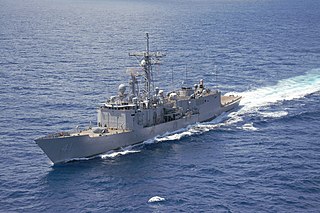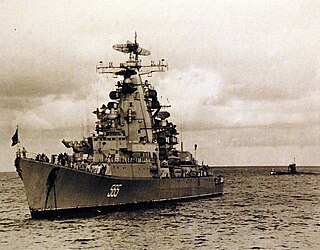
The Seventh Fleet is a numbered fleet of the United States Navy. It is headquartered at U.S. Fleet Activities Yokosuka, in Yokosuka, Kanagawa Prefecture, Japan. It is part of the United States Pacific Fleet. At present, it is the largest of the forward-deployed U.S. fleets, with 50 to 70 ships, 150 aircraft and 27,000 Sailors and Marines. Its principal responsibilities are to provide joint command in natural disaster or military operations and operational command of all US naval forces in the region.

The Russian Navy is the naval arm of the Russian Armed Forces. It has existed in various forms since 1696; its present iteration was formed in January 1992 when it succeeded the Navy of the Commonwealth of Independent States.

USS Merrill (DD-976), named for Rear Admiral Aaron Stanton Merrill USN (1890–1961), was a Spruance-class destroyer that entered service with the United States Navy in 1978. Merrill served as the US Navy's test platform for the Tomahawk cruise missile. In the 1980s, the destroyer took part in Operation Earnest Will in the Persian Gulf during heightened tensions with Iran. The destroyer was decommissioned in 1998. The vessel was used as a target ship in 2003 and sunk off Hawaii in 2003.

USS John S. McCain (DDG-56) is an Arleigh Burke-class destroyer currently in the service of the United States Navy. She is part of the Destroyer Squadron 23 within the Third Fleet, and has her homeport at Naval Station Everett in Everett, Washington.

USS Curtis Wilbur (DDG-54) is the fourth Arleigh Burke-class guided missile destroyer. Curtis Wilbur was named for Curtis D. Wilbur, forty-third Secretary of the Navy, who served under President Calvin Coolidge. In 2016, she was based at Yokosuka, Japan, as part of Destroyer Squadron 15.

USS Chancellorsville (CG-62) is a Ticonderoga-class guided-missile cruiser in service in the United States Navy. She is named for the Battle of Chancellorsville of the Civil War, which was a victory for the Confederate States Army. Until 30 December 2011, the ship was operationally part of Carrier Strike Group Seven. In 2010 she was administratively under the command of Commander, Naval Surface Forces Pacific. Currently she is assigned to Carrier Strike Group Five and is deployed to Yokosuka, Japan.

USS Benfold (DDG-65) is an Arleigh Burke-class destroyer in the United States Navy.

USS McClusky (FFG-41) was a Oliver Hazard Perry-class frigate of the United States Navy. She was named for Rear Admiral C. Wade McClusky (1902–1976) who as a lieutenant commander led the air group of USS Enterprise, which sank the Japanese carriers Kaga and Akagi during the Battle of Midway. McClusky later served as part of Destroyer Squadron 1, and after 31 years of service, was decommissioned on 14 January 2015 at Naval Base San Diego.

USS Fife (DD-991), a Spruance-class destroyer, was a ship of the United States Navy named for Admiral James Fife, Jr. (1897–1975), a distinguished Submarine Force commander during World War II.

The Udaloy class, Soviet designation Project 1155 Fregat and Russian designation Project 11551 Fregat-M, are series of anti-submarine guided-missile destroyers built for the Soviet Navy, seven of which are currently in service with the Russian Navy. Twelve ships were built between 1980 and 1991, while the thirteenth ship built to a modified design, known as Udaloy II class, followed in 1999. They complement the Sovremenny-class destroyers in anti-aircraft and anti-surface warfare operations. The codename Udaloy comes from an archaic Russian adjective удалой, meaning daring or bold.

The Russian cruiser Marshal Ustinov, is a Slava-class cruiser of the Russian Navy. The Russian name for the ship type is Raketnyy Kreyser (RKR), meaning "Missile Cruiser". The ship is named after Dmitriy Ustinov, a former Soviet Minister of Defence. Marshal Ustinov was assigned to the 43rd Missile Ship Division of the Russian Northern Fleet, whose homeport is in Severomorsk. From 2012 to 2016, the cruiser underwent a major overhaul. The vessel returned to service in 2017 and has since been deployed to the Mediterranean Sea.

Russian cruiser Varyag, is the third ship of the Slava-class of guided missile cruisers built for the Soviet Navy now serving the Russian Navy.

Marshal Shaposhnikov is a Udaloy-class destroyer of the Russian Navy commissioned in 1985. The vessel serves in the Russian Pacific Fleet. Her namesake is Marshal Boris Shaposhnikov.

The Pacific Fleet is the Russian Navy fleet in the Pacific Ocean.
Following the dissolution of the Soviet Union at the end of 1991, the Russian Navy struggled to adjust Cold War force structures while suffering severely with insufficient maintenance and a lack of funding. However, improvements in the Russian economy over the first decade of the twenty-first century led to a significant rise in defence expenditure and an increase in the number of ships under construction.

INS Shakti (A57) is a Deepak-class fleet tanker in service with the Indian Navy. She was built by Fincantieri, an Italian shipbuilding company based in Trieste. She is the second and final ship of her class. Shakti, along with her predecessor Deepak, is one of the largest ships of the Indian Navy.

INS Jyoti (A58) is the third of the four Komandarm Fedko-class replenishment oilers. She was modified for naval use and is now being operated by the Eastern Naval Command of the Indian Navy. Jyoti was the largest ship in the navy until INS Vikramaditya (R33) was commissioned in November 2013. Its primary role is fleet replenishment and sustaining blue-water operations. It was later fitted with close-in weapon systems for self-defence.

Admiral Tributs is a Project 1155 Large Anti-Submarine Ship of the Russian Navy. Known in the west as an Udaloy-class destroyer, the ship is named after Vladimir Filippovich Tributs. Launched in 1983, Admiral Tributs serves in the Russian Pacific Fleet, and has taken part in operations alongside the naval forces of other nations like China, India and Japan, and as part of a peacekeeping force in the Middle East between 1992 and 1993.

Vladivostok was the second Soviet Navy Project 1134 Admiral Zozulya-class Large Anti-submarine Ship also known as a Kresta I guided missile cruiser. Launched on 1 August 1966, the ship was reclassified a Large Rocket Ship on 3 August 1978 to reflect the wide-ranging capability of the vessel. Serving primarily in the Pacific Fleet during the Cold War, Vladivostok took part in exercises and tours that demonstrated Soviet naval power in the Indian and Pacific Oceans. The ship played a part at a number of points of potential escalation in the Cold War, including the Indo-Pakistani War of December 1971 and the collision between the aircraft carrier Kitty Hawk and the submarine K-314 in March 1984. Vladivostok was taken out of service to be modernised and updated on 28 September 1988 but there were insufficient funds to complete the work. Instead the ship was decommissioned on 19 April 1990 and, the following January, sold to an Australian company to be broken up.

Boyevoy was a Sovremenny-class destroyer of the Soviet and later Russian navy.



























